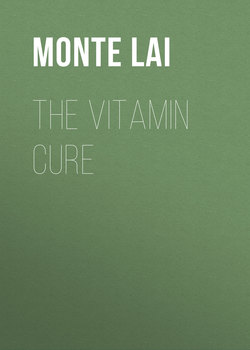Читать книгу The Vitamin Cure - Monte Lai - Страница 11
На сайте Литреса книга снята с продажи.
Оглавление2
VITAMIN B1 (THIAMINE)
Thiamine was the first B vitamin discovered; therefore, it was named vitamin B1. Vitamin B1 deficiency leads to beriberi disease. In 2600 BCE, ancient Chinese writings recorded the prevalence of beriberi disease in China. Dutch physicians in the 19th century noted that chickens fed only polished rice developed paralysis. Certain important nutrients seemed to be missing from polished rice. In the early 20th century, Casimir Funk isolated a water-soluble antineuritic substance from bran, the hard outer layer of cereal grain, and demonstrated that it could treat beriberi disease. He named the antineuritic substance “vitamine.” Vita in Latin means “life,” so a “vitamine” is required for life and was originally thought to be an amine.
Vitamin B1 obtained from foods is stored mostly in bones and muscles and the brain, heart, liver, kidneys, and other organs. Vitamin B1 participates in the conversion of carbohydrates and lipids into energy, and it is required for the synthesis of thiamine pyrophosphate, or TPP, a cofactor that is essential for a multitude of enzymes involved in energy production in the cell. Without TPP, the body would be unable to produce energy, leading to paralysis.
Which Diseases Are Associated with Vitamin B1 Deficiency?
Vitamin B1 deficiency can cause beriberi disease and Wernicke-Korsakoff syndrome. In addition, TPP deficiency may lead to neurodegenerative diseases as well as hereditary metabolic malfunction.
• Beriberi disease. The two major types of beriberi are wet beriberi and dry beriberi. Wet beriberi affects heart and blood circulation, while dry beriberi damages the nervous system. In extreme cases, it can cause paralysis. Symptoms of beriberi also include dementia, waddling, and foot edema.
• Wernicke-Korsakoff syndrome. Vitamin B1 deficiency can exacerbate Wernicke-Korsakoff syndrome, an alcohol-induced nerve-damaging disease. Symptoms include memory loss, jerky eyeball movements, disorientation, and a staggering gait. Alcohol abstinence may reverse the course of the disease. Untreated, it can lead to psychosis and even death.
What Are the Causes of Vitamin B1 Deficiency?
• Major causes of vitamin B1 deficiency are insufficient intake from foods, malabsorption, transport malfunction, increased demand, or excessive loss. Diseases and conditions that elevate the risk of vitamin B1 deficiency include alcoholism, AIDS, digestive tract disease, liver disease, and severe vomiting. People who are on hunger strike or suffer from anorexia are prone to vitamin B1 deficiency.
Prevention and Treatment of Diseases
• Treatment. Meta-analysis confirms that vitamin B1 can treat heart failure (74). Vitamin B1 may also be effective in Alzheimer’s disease (37), glaucoma (69), and cataracts (49).
• Prevention. Vitamin B1 may prevent cataracts (49) and type 2 diabetes (60).
Which Food Items Are Vitamin B1 Rich?
Vitamin B1–rich foods include beef, nuts, milk, oats, oranges, pork, eggs, and legumes. Vitamin B1–fortified foods include rice, spaghetti, breakfast cereals, bread, and flour. The recommended dietary allowance of vitamin B1 is only 1.5 mg, an amount readily obtainable from foods. However, vitamin B1 is water soluble; therefore, it cannot be stored in the body and needs to be replenished daily via food.
This list of vitamin B1–rich food items is adapted from information provided by the USDA.
| FOOD | PORTION | VITAMIN B1 CONTENT, MG | % DAILY REFERENCE VALUE |
|---|---|---|---|
| Pork | 3 ounces | 0.81 | 54 |
| Green beans | ½ cup | 0.21 | 14 |
| Brown rice | 1 cup | 0.19 | 13 |
| Walnuts | 1 ounce | 0.19 | 13 |
| Hyacinth beans | ½ cup | 0.17 | 7 |
| Oranges | 1 | 0.11 | 7 |
| Cantaloupes | ½ | 0.11 | 7 |
| Milk | 1 cup | 0.10 | 7 |
| Bread | 1 slice | 0.10 | 7 |
| Eggs | 1 | 0.03 | 2 |
Daily reference value of vitamin B1 is 1.5 mg according to the 2013 FDA food-labeling guidelines.
What Are the Recommended Dietary Allowances for Vitamin B1?
| 1–3 years | 0.5 mg |
| 4–8 years | 0.6 mg |
| 9–13 years | 0.9 mg |
| 14–18 years | 1.2 mg (boys); 1.0 mg (girls) |
| 19 years and older | 1.2 mg (men); 1.1 mg (women) |
There is currently no upper intake limit for vitamin B1.
Vitamin B1 Supplements
• Dosage. The most common dosage for vitamin B1 supplements is 100 mg. Vitamin B1 is relatively safe, and so far, there is no known toxicity.
• Types. Vitamin B1 supplements are made of benfotiamine, thiamine hydrochloride, and thiamine mononitrate. Among them, benfotiamine has the best absorption rate in the intestines.
• Diabetes. Randomized controlled trials have shown that benfotiamine was effective in mitigating symptoms and complications associated with both type 1 and type 2 diabetes, such as peripheral neuropathy and pain. The suggested daily dose of benfotiamine is 200 mg (50 mg four times per day) for three months.
• Heart failure. Vitamin B1 can treat heart failure (74). The recommended daily dose is 100 mg.
• Stress. Vitamin B1 is also known as the “antistress vitamin.” It boosts immune functions and regulates mood, thus increasing resistance to stressful conditions.
What Types of Drugs May Interact with Vitamin B1?
• Digoxin. Digoxin is a drug commonly prescribed to treat heart disease. Digoxin may interfere with the absorption of vitamin B1 by cardiac cells.
• Diuretics. Diuretics reduce the blood level of vitamin B1, thus increasing the risk of vitamin B1 deficiency. People who take diuretic medications to reduce the amount of water in the body should consider taking vitamin B1 supplements at a daily dose of 100 mg.
• Antibiotics. Antibiotics hinder the absorption of vitamin B1 by the intestines, thus reducing the blood level of vitamin B1.
